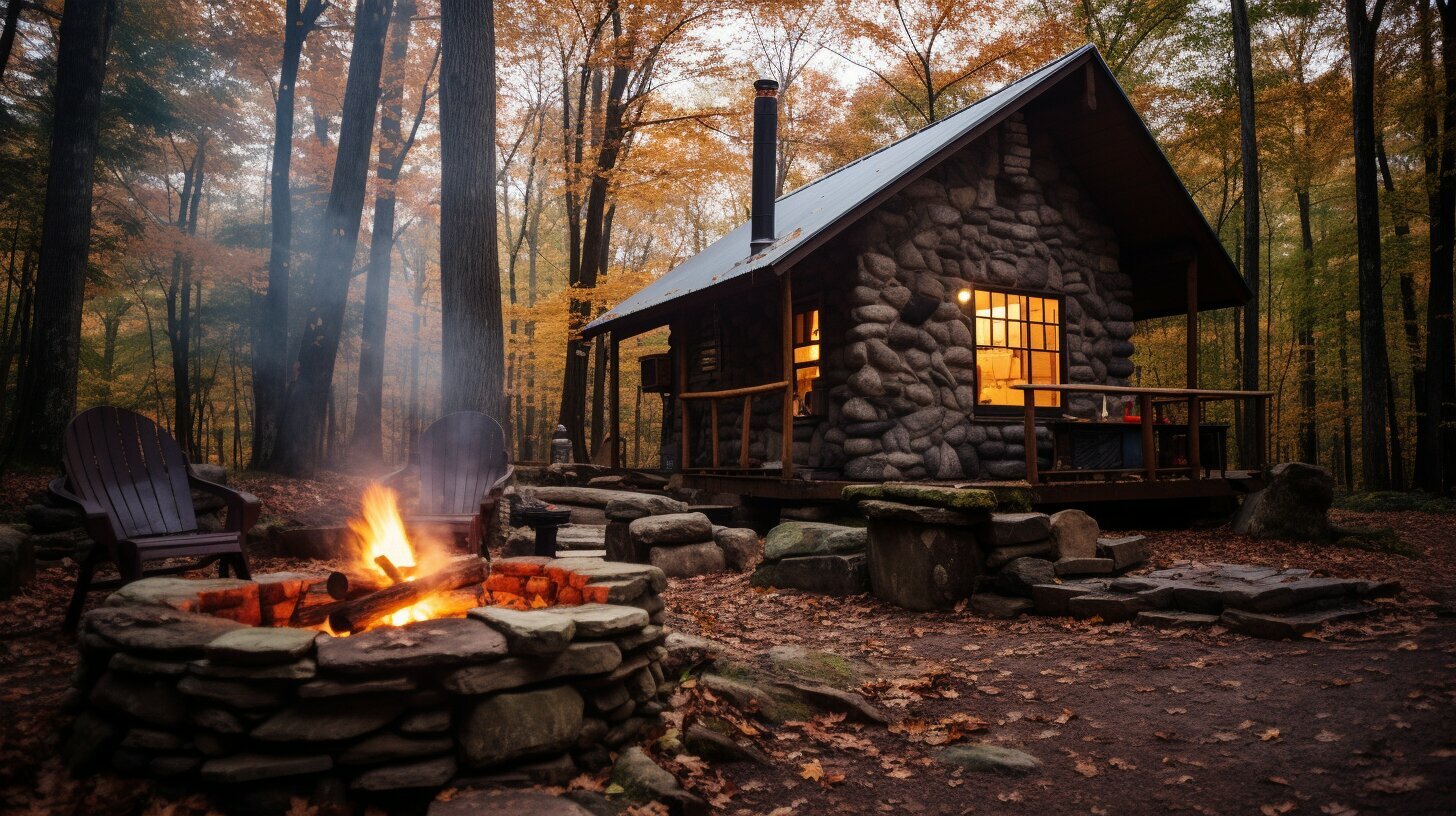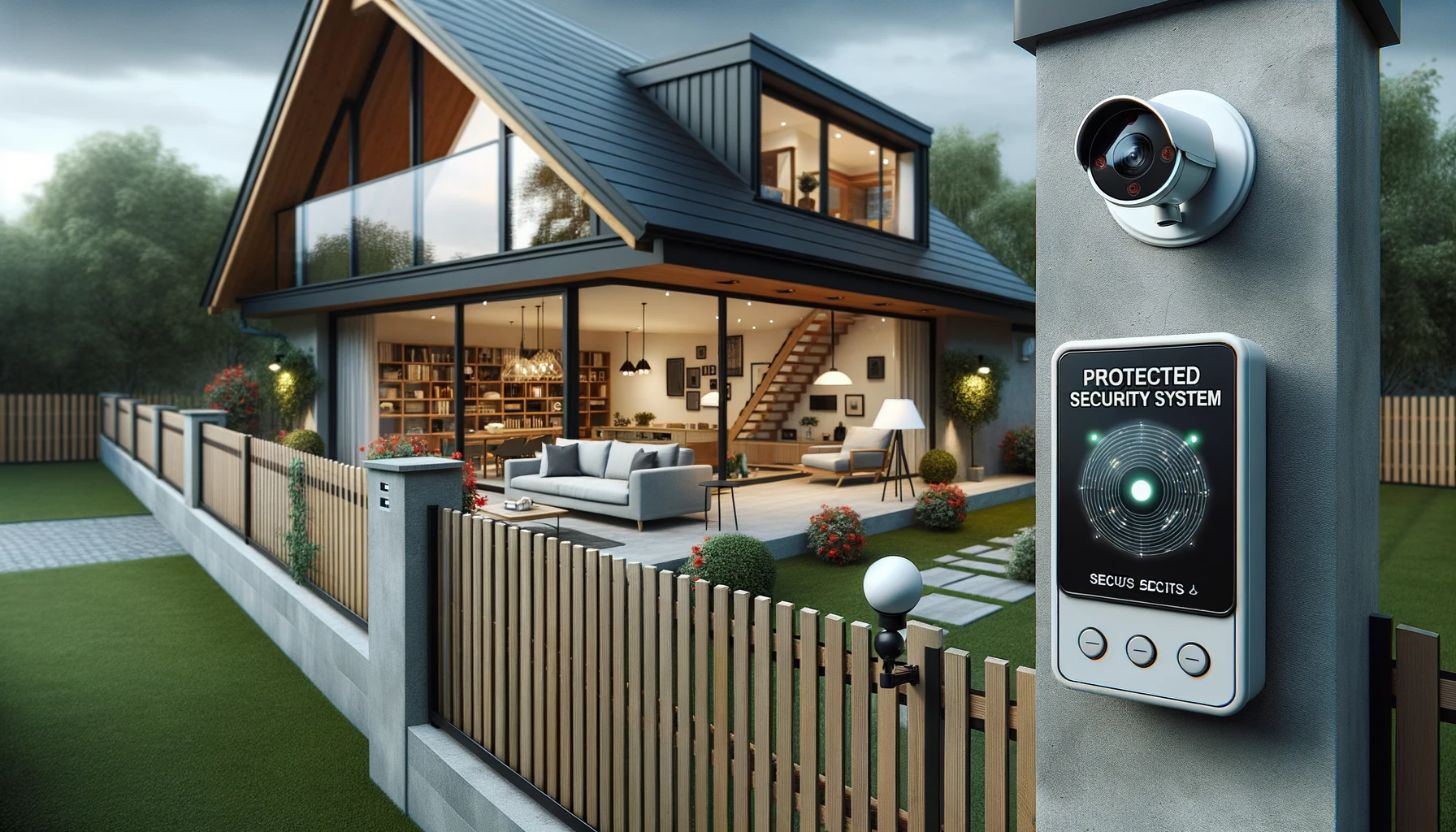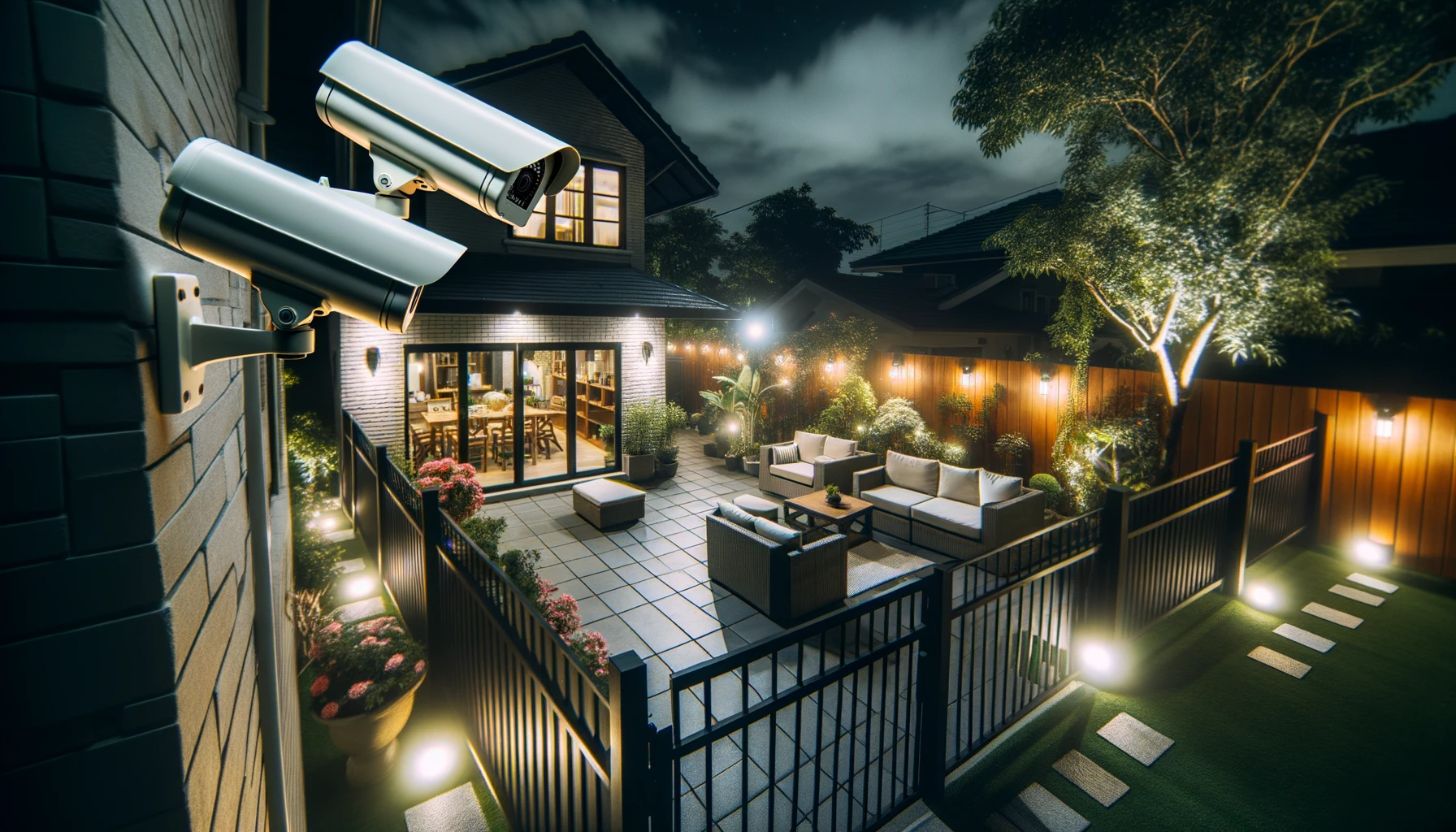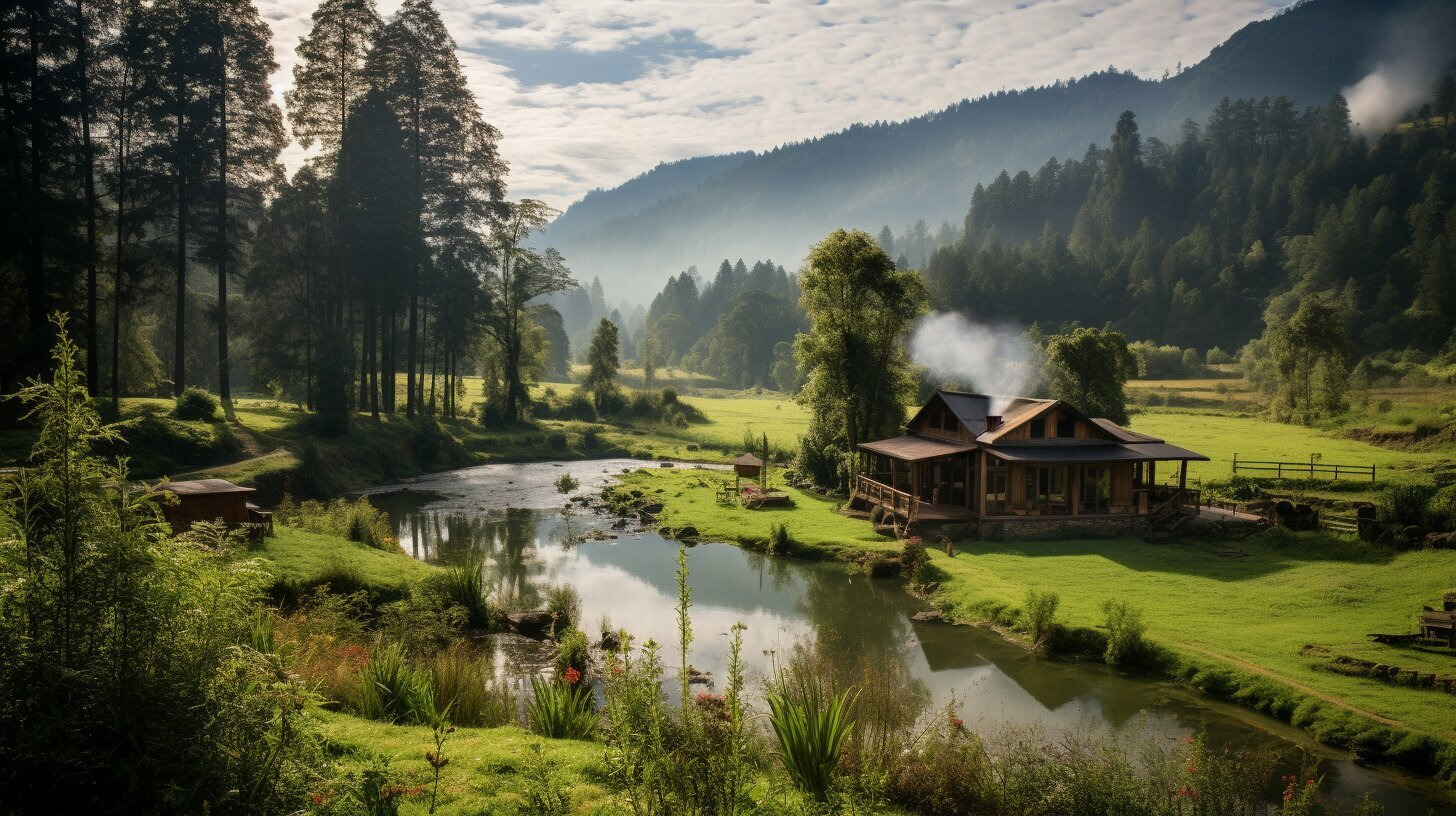If you’re looking for a survival shelter or an emergency retreat, a bug out cabin is an excellent option. But, designing and building a cabin that can withstand various environmental challenges requires careful planning and consideration. In this section, we’ll provide you with a guide for creating your perfect bug out cabin. We’ll cover all the essential aspects, including location, design, and features, that will ensure your safety and comfort during emergencies.
Whether you’re a prepper or someone looking for a wilderness getaway, a bug out cabin will serve as your self-sustaining cabin and off-grid sanctuary. It can provide you with a comfortable and safe environment to wait out a storm, a pandemic, or any other crisis. But, before you start building, there are a few factors you need to consider to ensure your cabin meets your needs and offers maximum protection.
Key Takeaways
- A bug out cabin is an excellent option for a survival shelter or emergency retreat.
- Careful planning and consideration are necessary to design and build a cabin that can withstand various environmental challenges.
- A bug out cabin can serve as a self-sustaining cabin and off-grid sanctuary.
- Location, design, and features are essential factors to consider when building your bug out cabin.
- With proper planning and design, your bug out cabin can be a comfortable and safe environment to wait out any crisis.
Importance of a Bug Out Cabin
If you’re serious about preparing for emergencies, having a bug out cabin is an absolute necessity. In times of crisis, having a dedicated space away from urban areas can be a lifesaver. Your bug out cabin can act as an emergency retreat and disaster preparedness shelter, providing a safe haven for you and your loved ones.
When considering the importance of a bug out cabin, it’s essential to remember that disasters can strike at any moment, leaving you with no time to waste. Having a pre-planned bug out location can help you avoid the chaos and confusion that comes with an emergency situation.
Disclosure: When you buy through links on our site, we may earn an affiliate commission.
Ultimately, having a bug out cabin provides you with a sense of security and peace of mind. Knowing that you have a safe place to go when disaster strikes can reduce stress and anxiety, allowing you to focus your attention on survival.
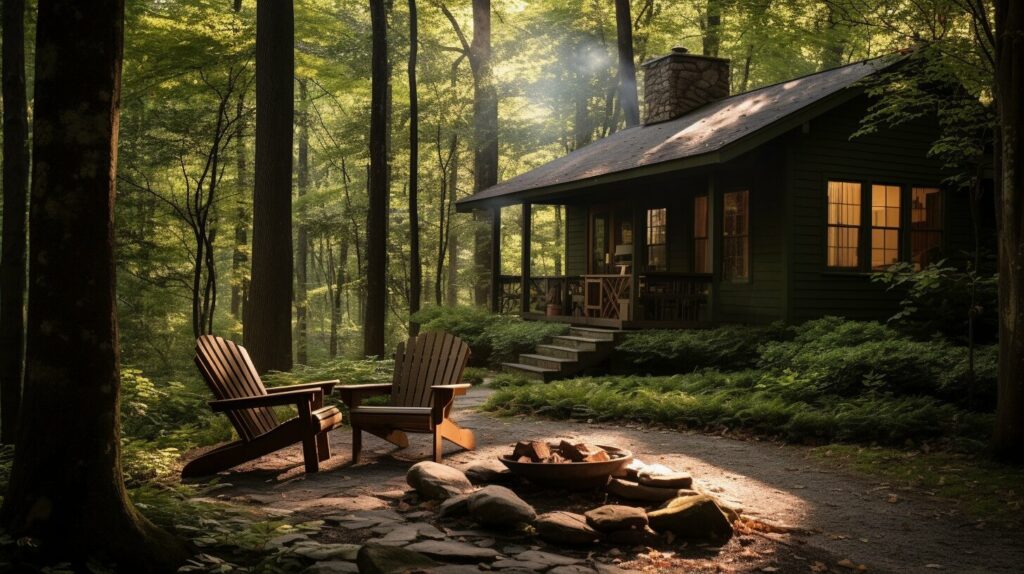
“In times of crisis, having a dedicated space away from urban areas can be a lifesaver.”
Choosing the Right Location
When it comes to selecting the perfect location for your bug out cabin, there are several factors you should consider. You want a place that is far from urban areas, access to resources, and is secure enough to protect you in times of crisis. Here are some top locations for your wilderness getaway:
| Location | Description |
|---|---|
| Mountains | Mountainous areas offer seclusion and protection, as well as access to resources such as water and wood. |
| Forests | A forest location provides cover and concealment, as well as resources for food and shelter. |
| Isolated Islands | Isolated islands offer security and isolation, as well as access to marine resources for food and water. |
It’s important to remember that the location you choose needs to be accessible by foot or four-wheel drive. It also needs to have easy access to a water source and should not be in a flood-prone area. Choosing the right location will ensure your bug out cabin is the ultimate wilderness getaway.

Designing Your Bug Out Cabin
Designing your bug out cabin is an essential aspect of creating your off-grid sanctuary. A self-sustaining cabin that is equipped with the necessary facilities will ensure your survival and comfort during challenging times.
Firstly, you will need to consider the size of your cabin. It should be large enough to accommodate your family members and any additional guests. However, sacrificing size for quality is recommended, as it will be difficult to maintain a larger cabin in the long run.
Next, you will need to choose the type of foundation and construction materials that will suit the location and environment of your cabin. Make sure to use durable and high-quality materials that can withstand harsh weather conditions and other environmental challenges.
One of the essential features of your bug out cabin is its ability to generate renewable energy. Installing solar panels or wind turbines can be a reliable source of energy for your off-grid sanctuary. Make sure to assess the energy needs of your cabin and choose the appropriate renewable energy source accordingly.
Water and Waste Management
Water and waste management are crucial aspects of your bug out cabin’s design. Rainwater harvesting systems can help you collect and store water for your daily needs. It’s also recommended to install a water filtration system to ensure the quality and safety of the water you’re consuming.
You’ll also need to install a waste management system to dispose of wastewater and other types of waste. A composting toilet can be an eco-friendly and practical solution for your bug out cabin.
Finally, make sure your cabin is well-insulated and properly ventilated. This will help maintain a comfortable temperature and prevent moisture buildup that can lead to mold growth and other problems.
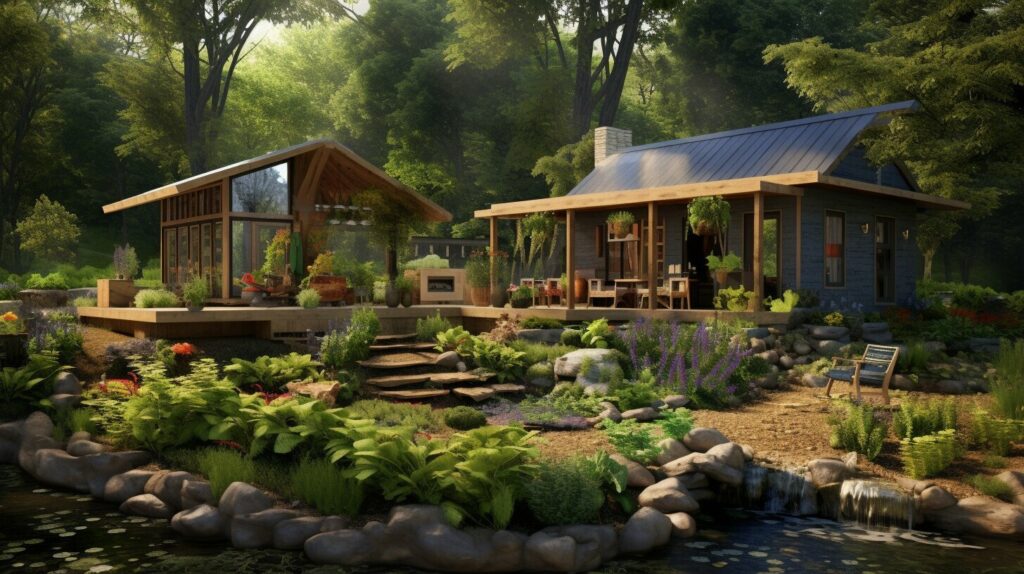
Remember, designing your bug out cabin should prioritize functionality and sustainability over aesthetics. Focus on creating a self-sustaining cabin that will ensure your survival and comfort in times of crisis.
Essential Features for Survival
When it comes to building your bug out cabin, it’s crucial to keep in mind that it needs to provide adequate shelter and protection for you and your loved ones. Here are some essential features to consider to ensure your cabin is a survival shelter, emergency retreat, or disaster preparedness shelter:
Secure Entryway
One of the most important things to consider is having a secure entryway. Your emergency retreat needs to be able to keep intruders out while providing a safe place for you and your loved ones.
Renewable Energy Sources
In times of emergency, you may not have access to power. Consider installing renewable energy sources like solar panels, wind turbines, or hydroelectric generators to ensure your cabin has a reliable source of electricity.
Water Storage and Filtration
Having access to clean water is essential for survival. Ensure your emergency retreat has a water storage system and filtration system to provide clean water for drinking, cooking, and bathing.
Food Storage and Preparation
Stock your survival shelter with non-perishable food items, utensils, and a cooking source. Consider installing a wood-burning stove, as it can provide heat and a place for cooking.
First Aid Kit
Having a comprehensive first aid kit is crucial for treating injuries and illnesses. Stock it with bandages, antiseptics, pain relievers, and any necessary prescription medications.
Communication Devices
During an emergency, it’s essential to have a way to communicate with the outside world. Consider including cell phones, two-way radios, or satellite phones.
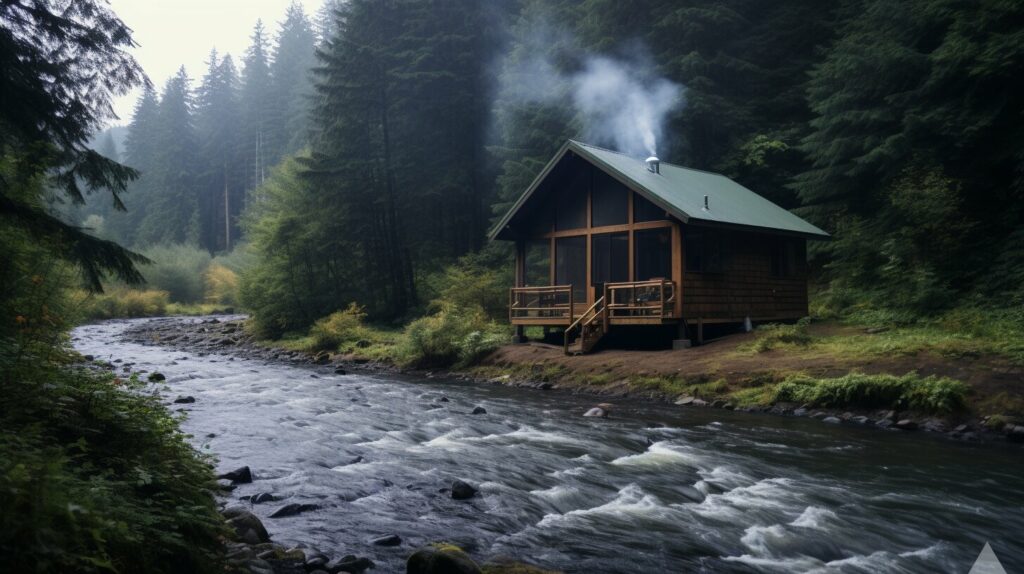
Fire Extinguishers
Installing fire extinguishers in your emergency retreat is essential to putting out any fires that may start. Ensure they are easily accessible and in working order.
Sanitation Facilities
In addition to water storage and filtration, you’ll need to ensure your survival shelter has sanitation facilities, such as a composting toilet or an outhouse.
Security Measures
Ensure your survival shelter has various security measures to keep you and your loved ones safe. Consider installing security cameras, motion sensors, or even a fence to keep intruders out.
By including these essential features into your bug out cabin, you’ll be well on the way to creating a reliable and sustainable emergency retreat that can provide shelter and protection in times of crisis.
Building and Maintaining Your Cabin
Building a self-sustaining bug out cabin requires careful planning and construction. You need to consider the materials and techniques that will provide a durable structure. Here are some essential tips to help you build and maintain your bug out cabin:
Construction Materials
Choosing the right materials is critical when building a sustainable and self-sufficient cabin. Select materials that are durable, environmentally friendly, and locally sourced if possible. Utilize natural materials that blend with the surroundings, such as timber, stone, and clay. Incorporating recycled materials like reclaimed wood can also help reduce your environmental impact.
Construction Techniques
When building a self-sustaining cabin, it’s essential to utilize construction techniques that maximize energy efficiency and minimize waste. Consider using passive solar design principles that capture and store heat from the sun to provide warmth in the winter months. Also, use high-quality insulation to maintain a comfortable indoor temperature and reduce energy consumption. Additionally, installing windows and skylights can allow natural light into the cabin, reducing the need for artificial lighting and saving electricity.
Maintenance
Maintaining your bug out cabin is essential to ensure it lasts for as long as possible. A regular maintenance schedule should be put in place, including routine inspections, cleaning, and repairs. Regular inspections can identify potential problems before they become serious, resulting in expensive repairs. Cleaning your gutters, checking your roof, and replacing worn-out materials are just a few essential maintenance tasks to keep your cabin in optimal condition.
Seasonal Preparations
It’s crucial to prepare your cabin for every season to withstand extreme weather conditions and ensure your comfort. Check for air leaks and repair them before winter to keep your cabin warm and energy-efficient. Also, ensure your water supply is adequately insulated to prevent pipes from freezing and possibly bursting. Preparing for the summer months may include trimming trees and bushes to reduce the risk of wildfires, ensuring your cabin is fire-resistant, and installing measures to keep pests like mosquitoes and rodents at bay.
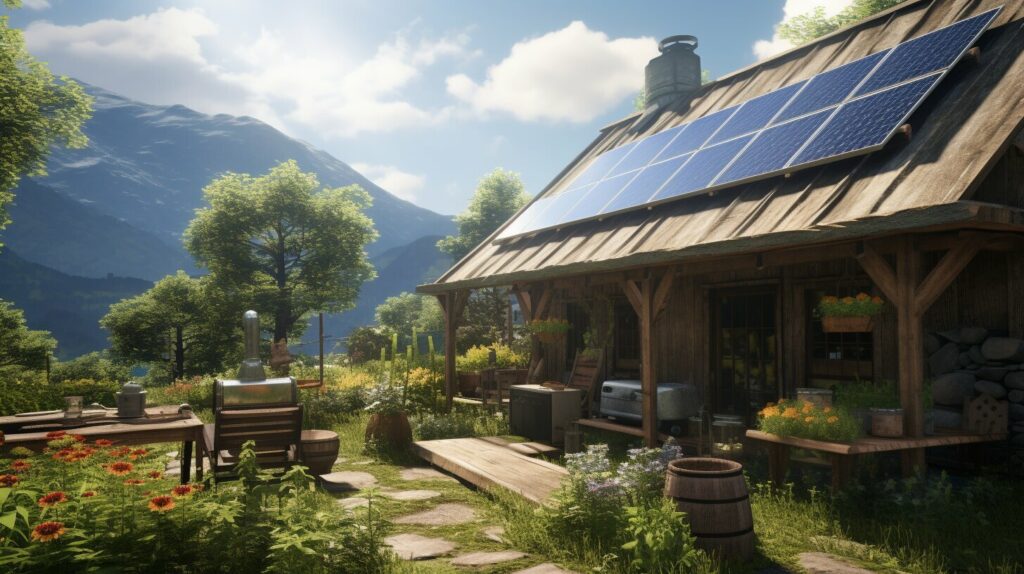
Tip: Consider hiring a professional contractor with experience building self-sustaining cabins to help you construct and maintain your bug out cabin. They can provide expert advice, recommend materials and techniques, and ensure your cabin is built to code and meets all safety standards.
Supplies and Equipment
When stocking your bug out cabin, it’s essential to consider the supplies and equipment you need to ensure your survival in times of crisis. Here are some important items to include:
- First aid kit with essential medical supplies
- Cooking gear such as a camp stove and cookware
- Water filtration and purification systems
- Communication devices such as a two-way radio or satellite phone
- Navigation tools such as a compass and topographical map
- Emergency shelter such as a high-quality, waterproof tent
- Fire-starting tools such as matches or a lighter
- Self-defense tools such as a firearm or pepper spray
- Extra clothing and sturdy boots
- Hygiene items such as soap, toothbrush, and toilet paper
- Portable power source such as solar panels or generators
- Emergency cash and important documents
Altitude-Adjustment Chamber
Additionally, some preppers include an altitude-adjustment chamber in their bug out cabin. This is because, in case of an emergency, you may need to quickly adjust to a high altitude. An altitude-adjustment chamber helps you acclimate to higher altitudes, preventing altitude sickness and other related issues.
These are just a few of the essential supplies and equipment you should consider including in your bug out cabin. Make sure to tailor your supplies to meet your specific needs and requirements to ensure you’re adequately prepared for any emergency situation.
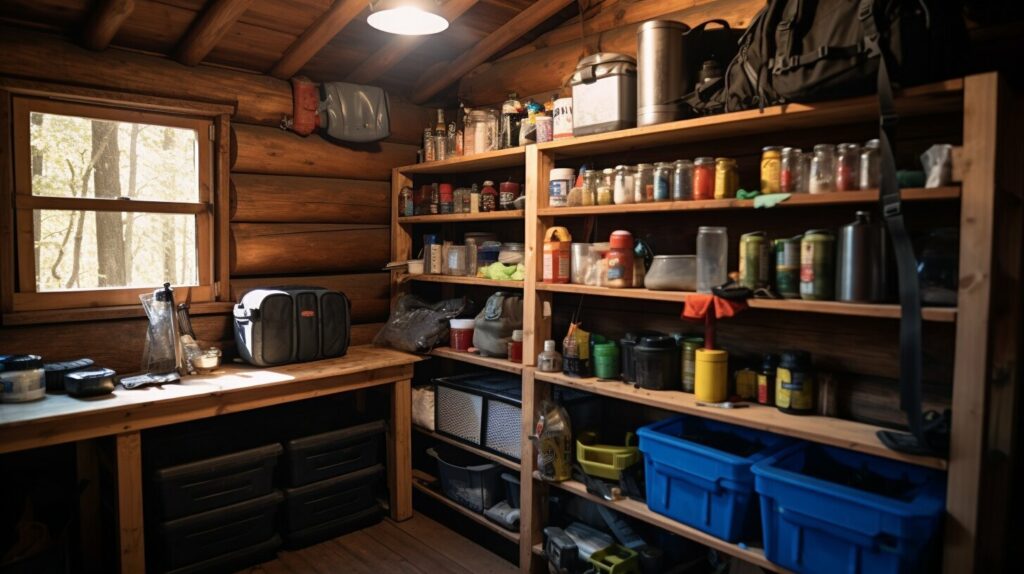
Security Measures
Your bug out cabin can serve as an effective emergency retreat and off-grid sanctuary to keep you safe during times of crisis. However, ensuring its security is vital to protect your family and possessions. Here are some security measures you can implement to safeguard your bug out cabin:
- Perimeter fencing: Erect a sturdy fence around the perimeter of your bug out cabin to prevent unauthorized access and deter intruders. Use high-quality materials such as chain link, barbed wire, or wood to make it difficult to breach.
- Surveillance: Install security cameras and motion sensors to monitor the perimeter and interior of your bug out cabin. Consider using a wireless system that can be remotely accessed from a secure location.
- Defensive measures: Equip your bug out cabin with defensive weapons such as firearms, pepper spray, or tasers to protect yourself from potential threats. Ensure you’re adequately trained to use them and keep them out of reach of children.
Implementing these security measures can help safeguard your bug out cabin and provide peace of mind knowing that you’re prepared to defend yourself in an emergency.
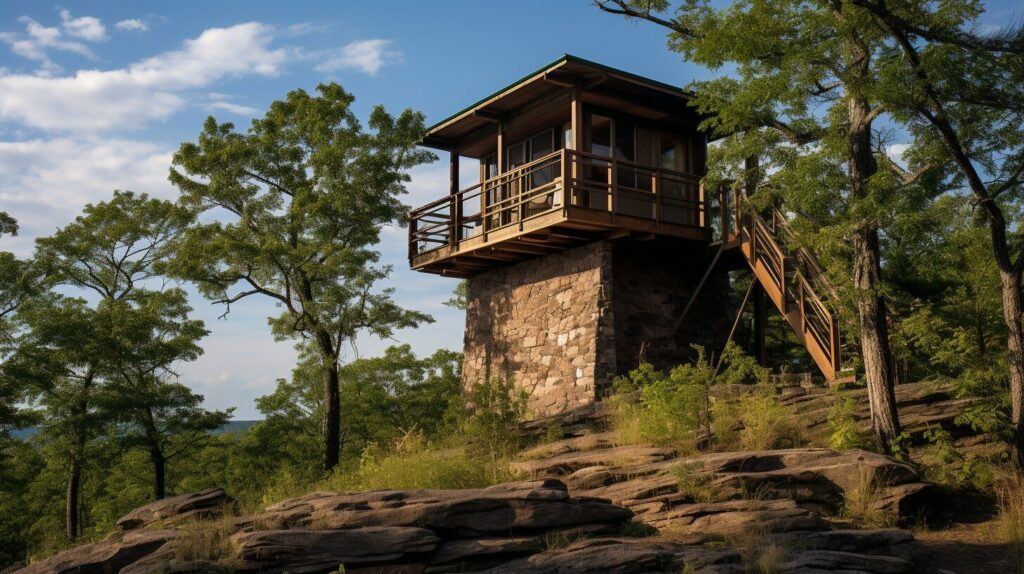
Sustainable Living Strategies
Creating a self-sustaining cabin is a crucial aspect of bug out cabin preparation. In addition to providing shelter, your cabin should also be able to support your basic needs.
One sustainable living strategy to consider is rainwater harvesting. This involves collecting rainwater in storage tanks for future use. To implement this, you can install a rainwater catchment system on your roof, and the water collected can be filtered for drinking or used for irrigation of your garden.
Another strategy is the use of renewable energy sources like solar panels, wind turbines, or hydro turbines. These can generate electricity to power your cabin, charge batteries, and run appliances.
Permaculture principles can also be applied to your design, allowing you to grow your food and use local resources to meet your needs. Strategies such as companion planting, natural pest control, and using organic fertilizers can help you create a thriving and sustainable garden.
By implementing these sustainable living strategies, you can create an off-grid sanctuary that can sustain your basic needs and provide a comfortable living space.
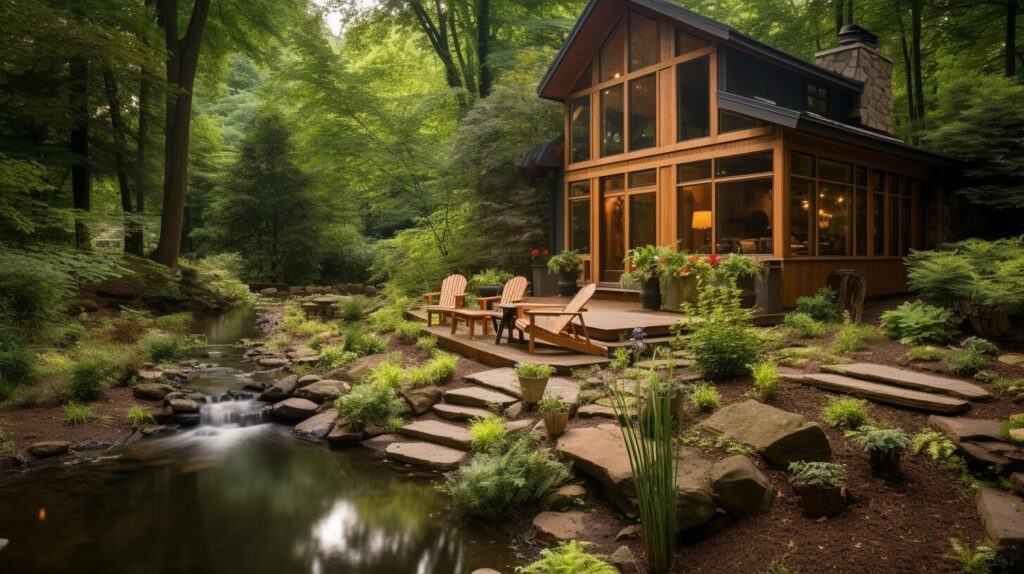
Bug Out Cabin Maintenance
Once your bug out cabin is built and fully stocked, it’s important to maintain it regularly to ensure it stays in top condition. Not only can regular maintenance prevent small problems from becoming bigger issues, but it can also increase the longevity of your shelter and help you avoid costly repairs in the future. Here are some essential bug out cabin maintenance tips to keep in mind:
Routine Maintenance Tasks
Regularly check your bug out cabin for any signs of wear and tear. Inspect the roof, walls, windows, and doors for any cracks, leaks, or damage that needs to be repaired. Clear any debris from the roof, gutters, and around the perimeter to prevent clogging and water damage.
Test all your systems, including the plumbing, electrical, and heating, to make sure they’re working properly. Stock up on spare parts and tools for any repairs that may need to be made.
Repairs
If you find any issues during routine maintenance, it’s important to address them immediately to prevent them from getting worse. Repair any leaks, cracks, or damage promptly to avoid further damage to your bug out cabin. Have a designated area for tools and spare parts so that you can quickly find what you need when a repair is necessary.
Seasonal Preparations
Preparing your bug out cabin for the changing seasons is important to ensure your survival and comfort. Make sure to prepare for harsh weather conditions, such as snowstorms or hurricanes, by stocking up on necessary supplies, including food, water, and fuel. Insulate your cabin to keep it warm in the winter and cool in the summer.
Pest Control
Keep your bug out cabin free of pests by practicing good sanitation habits and preventing access points. Seal any cracks or holes that may allow pests to enter and store food in airtight containers. Set up natural pest control measures, such as planting herbs and flowers that repel insects, to keep pests at bay.
By following these essential maintenance tips, you can ensure that your bug out cabin remains a functional and safe survival shelter for years to come.
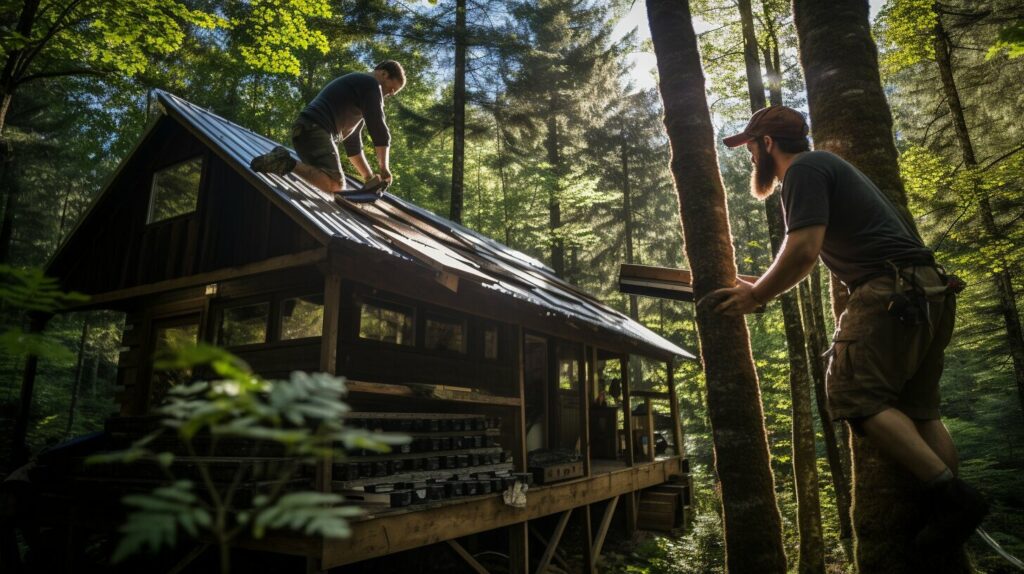
Bug Out Cabin Checklist
When it comes to preparing your bug out cabin, having a comprehensive checklist is essential. Here are some of the key items and considerations you should include:
Location:
- Remote and isolated area away from urban areas and major roads
- A secure and defensible site with natural barriers
- Access to clean water sources and renewable energy options
Design and Features:
- A sturdy and durable structure with proper insulation
- Off-grid facilities, including a solar-powered generator and water filtration system
- Multiple layers of security for protection against intruders
- Sufficient food and water storage for at least one year
Supplies and Equipment:
- A first aid kit with essential medication and supplies
- Cooking gear and utensils for preparing food
- Communication devices, such as radios and walkie-talkies
- Ammunition and firearms for self-defense
Security Measures:
- Perimeter security, including fencing and lighting
- Surveillance systems, such as motion sensors and security cameras
- Defensive measures, such as booby traps and hidden exits
Sustainable Living Strategies:
- Water harvesting techniques, such as rain barrels and catchment systems
- Agricultural practices, such as permaculture and aquaponics
- Renewable energy sources, such as wind turbines and solar panels
By following this checklist, you’ll be well on your way to creating the perfect bug out cabin that will serve as a survival shelter and emergency retreat for you and your loved ones in times of crisis.
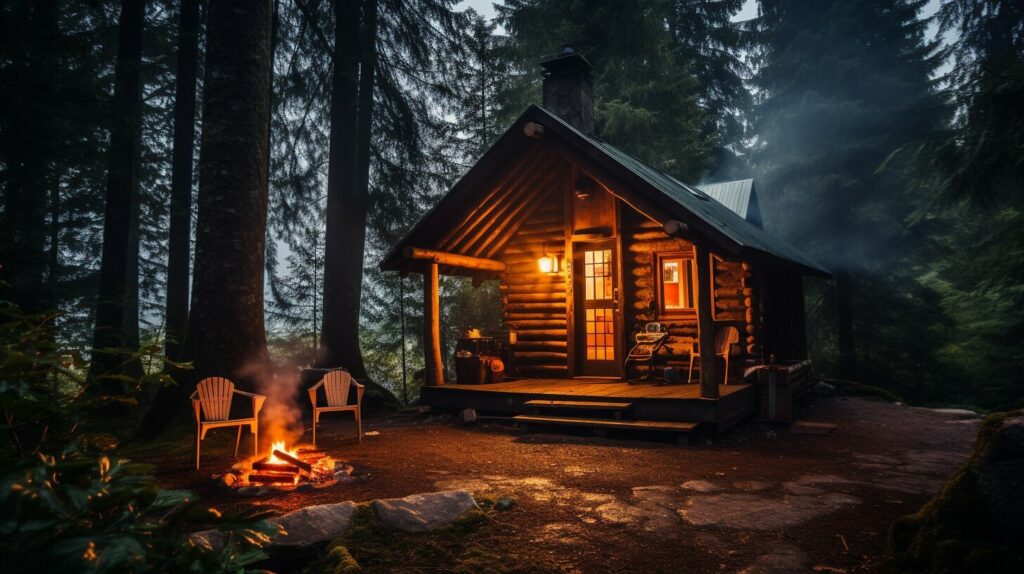
Conclusion
By now, you should have a solid understanding of the importance of having a wilderness getaway and disaster preparedness shelter for survival during emergencies.
Remember to carefully consider the location of your bug out cabin, taking into account accessibility, resources, and security. Design a self-sustaining cabin that includes essential features for survival, such as renewable energy sources and water storage options.
Building and maintaining your cabin may seem like a challenging task, but with the right construction materials and techniques, you can create a sustainable and durable structure that will last for years to come.
Stock your bug out cabin with necessary supplies and equipment, including first aid kits, cooking gear, and communication devices. Implement security measures to safeguard your wilderness getaway, and consider sustainable living strategies, such as permaculture principles and rainwater harvesting, to achieve self-sufficiency in the long run.
Stay Prepared for Emergencies
Regular maintenance of your bug out cabin is crucial to ensure its longevity and functionality. Use the provided bug out cabin checklist to address all essential items and considerations. By following this guide, you’ll be well-prepared for any emergency situation and be able to thrive in your wilderness getaway and disaster preparedness shelter.
Remember, in challenging times, having a bug out cabin can make all the difference. Stay safe, be prepared, and enjoy your wilderness getaway!
FAQ
What is a bug out cabin?
A bug out cabin is a dedicated space that serves as an emergency retreat and survival shelter. It is designed to provide you with a safe and secure location away from urban areas during times of crisis or disaster.
Why is having a bug out cabin important?
Having a bug out cabin is important because it offers a dedicated space for you to retreat to in case of emergencies. It provides you with the necessary resources and facilities to survive and thrive during challenging times.
How do I choose the right location for my bug out cabin?
When choosing the right location for your bug out cabin, factors such as accessibility, available resources, and security should be considered. Look for top locations that provide a wilderness getaway and are ideal for survival purposes.
What should I consider when designing my bug out cabin?
When designing your bug out cabin, consider creating an off-grid sanctuary that is self-sustaining. Ensure it is equipped with the necessary facilities such as renewable energy sources, water and food storage options, and security measures.
What are the essential features I should include in my bug out cabin?
Essential features for your bug out cabin include security measures, renewable energy sources, and water and food storage options. These features enhance your survival capabilities and ensure you are prepared for emergencies.
How do I build and maintain my bug out cabin?
To build your bug out cabin, consider using construction materials and techniques that are durable and sustainable. Regular maintenance tasks, repairs, and seasonal preparations are necessary to keep your cabin in optimal condition.
What supplies and equipment should I stock my bug out cabin with?
Stock your bug out cabin with essential supplies and equipment such as first aid kits, cooking gear, and communication devices. These items will ensure you are adequately prepared for emergencies.
How can I enhance the security of my bug out cabin?
Implement security measures such as securing the perimeter, installing surveillance options, and considering defensive measures to enhance the security of your bug out cabin.
What sustainable living strategies are recommended for my bug out cabin?
Sustainable living strategies for your bug out cabin include rainwater harvesting, renewable energy generation, and following permaculture principles. These strategies help you achieve self-sufficiency in the long run.
How do I maintain my bug out cabin?
Regular maintenance tasks, repairs, and seasonal preparations are essential for maintaining your bug out cabin. These measures ensure its longevity and functionality.
Is there a checklist for bug out cabin essentials?
Yes, there is a comprehensive bug out cabin checklist that covers all the essential items and considerations you need to address. This checklist serves as a handy reference to ensure you are fully prepared for any emergency situation.

